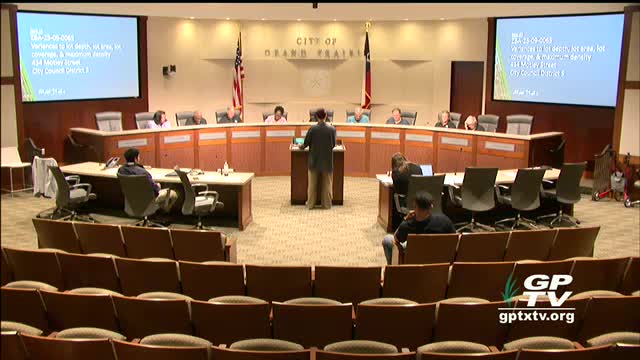ZBA rejects developer’s request for three townhomes at 434 Motley Street, votes 4-5
October 20, 2025 | Grand Prairie, Dallas County, Texas
This article was created by AI summarizing key points discussed. AI makes mistakes, so for full details and context, please refer to the video of the full meeting. Please report any errors so we can fix them. Report an error »

The Zoning Board of Adjustments on Oct. 20 voted 4–5 to deny a set of variances that would have let a developer split 434 Motley Street into three attached townhome lots.
Staff presentation and findings: City staff told the board the lot is zoned 2F and the applicant sought variances to reduce minimum lot depth (required 100 feet; proposed 68 feet for each lot), to reduce minimum lot area for the middle lot from 3,300 square feet to about 2,040 square feet, and to increase maximum lot coverage for the middle lot from 60% to roughly 60.3%. The applicant provided an updated survey that removed an earlier maximum-density variance. Staff said it could support the lot-depth variance but recommended against the lot-area and lot-coverage variances, describing them as self-created hardships because the owner could, under existing zoning, build a duplex without subdividing the lot.
Applicant comments: Applicant Ozil Zuniga (appearing as the developer) described the neighborhood mix of single-family, 2-family and multifamily uses nearby and said he recently built and rented three similar townhomes a block away. He told the board the proposed homes would have about 800 square feet of living area per unit (two stories), two-car garages and private yards, and that dividing the site into three units would make rents more affordable by spreading land cost across more units. "A lot of people had told me, 'I really like these townhomes,'" he said, arguing the design would not be out of place in a mixed-zoning area with nearby apartment complexes.
Board discussion and outcome: Commissioners discussed the established lot pattern in the area and whether approving three smaller lots would be consistent with surrounding parcels, which staff said are generally larger (0.1–0.13 acres). Several board members questioned whether the hardships were self-created because the land could be developed with fewer units without variances. After discussion, a motion to approve the variances (moved and seconded as recorded) failed 4–5.
Why it matters: The decision preserves existing lot-pattern norms in the neighborhood and denies a developer’s proposal to increase housing units on the parcel through subdivision. Staff and several board members emphasized the distinction between options allowed by right under existing zoning and proposals that the applicant seeks through variance.
Next steps: The applicant may revise the proposal (for example, to build a duplex) or return with further evidence if they seek to demonstrate a non–self-created hardship.
Staff presentation and findings: City staff told the board the lot is zoned 2F and the applicant sought variances to reduce minimum lot depth (required 100 feet; proposed 68 feet for each lot), to reduce minimum lot area for the middle lot from 3,300 square feet to about 2,040 square feet, and to increase maximum lot coverage for the middle lot from 60% to roughly 60.3%. The applicant provided an updated survey that removed an earlier maximum-density variance. Staff said it could support the lot-depth variance but recommended against the lot-area and lot-coverage variances, describing them as self-created hardships because the owner could, under existing zoning, build a duplex without subdividing the lot.
Applicant comments: Applicant Ozil Zuniga (appearing as the developer) described the neighborhood mix of single-family, 2-family and multifamily uses nearby and said he recently built and rented three similar townhomes a block away. He told the board the proposed homes would have about 800 square feet of living area per unit (two stories), two-car garages and private yards, and that dividing the site into three units would make rents more affordable by spreading land cost across more units. "A lot of people had told me, 'I really like these townhomes,'" he said, arguing the design would not be out of place in a mixed-zoning area with nearby apartment complexes.
Board discussion and outcome: Commissioners discussed the established lot pattern in the area and whether approving three smaller lots would be consistent with surrounding parcels, which staff said are generally larger (0.1–0.13 acres). Several board members questioned whether the hardships were self-created because the land could be developed with fewer units without variances. After discussion, a motion to approve the variances (moved and seconded as recorded) failed 4–5.
Why it matters: The decision preserves existing lot-pattern norms in the neighborhood and denies a developer’s proposal to increase housing units on the parcel through subdivision. Staff and several board members emphasized the distinction between options allowed by right under existing zoning and proposals that the applicant seeks through variance.
Next steps: The applicant may revise the proposal (for example, to build a duplex) or return with further evidence if they seek to demonstrate a non–self-created hardship.
View full meeting
This article is based on a recent meeting—watch the full video and explore the complete transcript for deeper insights into the discussion.
View full meeting
